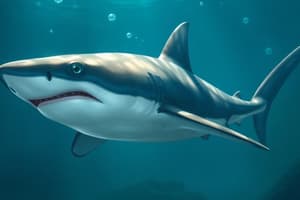Podcast
Questions and Answers
Which of the following factors does NOT affect the annual variation in Phaeophyta?
Which of the following factors does NOT affect the annual variation in Phaeophyta?
- Color of the water (correct)
- Diurnal variation
- Nutrient mixing
- Tides
Diurnal variation refers to changes that occur over a daily cycle.
Diurnal variation refers to changes that occur over a daily cycle.
True (A)
What is meant by thermocline position in relation to Phaeophyta?
What is meant by thermocline position in relation to Phaeophyta?
The depth at which water temperature changes significantly, affecting nutrient mixing.
The phenomenon of nutrient mixing is affected by the ________ position.
The phenomenon of nutrient mixing is affected by the ________ position.
Match the following factors with their effects on Phaeophyta:
Match the following factors with their effects on Phaeophyta:
Flashcards
Annual Variation
Annual Variation
The changes in environmental factors, such as temperature, salinity, and nutrients, over a year.
Duration of Maximum and Minimum
Duration of Maximum and Minimum
The period of time when a specific environmental factor reaches its maximum and minimum values.
Diurnal Variation
Diurnal Variation
The changes in environmental factors over a 24-hour period.
Stratification
Stratification
The layering of water in a body of water based on temperature and density.
Signup and view all the flashcards
Thermocline Position
Thermocline Position
The boundary between warm and cold water layers, which can influence nutrient mixing and distribution.
Signup and view all the flashcardsStudy Notes
Marine Biology/Ecology Introduction
- Oceans cover nearly 71% of Earth's surface, and their physical characteristics impact daily life
- Marine organisms are a crucial food and natural product source
- Ocean productivity (food production and organism count) is a key area of marine biology
- Marine organisms are important for studying various scientific fields (e.g., ecology, physiology, biochemistry, biogeography, behavior, genetics, evolution)
Oceanography
- Oceanography is the study of the oceans, phenomena like waves, currents, and tides
- It encompasses various disciplines: chemistry, physics, geology, geography, meteorology, and biology
- Oceanography and marine biology are interrelated and often overlap
History of Marine Biology
- Human interest in the sea dates back to ancient civilizations (Greeks, Romans)
- Aristotle was an early naturalist, creating a classification scheme
- Charles Darwin's HMS Beagle expedition is significant
- The Challenger expedition (1872-1876) marked a turning point in marine science, leading to modern marine biology and oceanography
- Exploration of the Arctic and Antarctic regions further advanced knowledge about marine life
- Important individuals like Alexander and Louis Agassiz have contributed to understanding of ocean life and marine biology
Geography and Geomorphology of Oceans/Seas
- Marine environments are divided into pelagic (water column) and benthic (ocean floor) divisions
- Pelagic zone is further subdivided into neritic zone (over continental shelves) and oceanic zone (deep ocean basins)
- Other pelagic divisions include photic zone (sunlight) and aphotic zone (no sunlight)
- Benthic division starts with the intertidal zone.
Temperature and Vertical Stratification
- Temperature is a measure of molecular energy, varying geographically and with depth in the ocean
- Poikilothermic (ectothermic) organisms (except mammals and birds) have body temperatures that vary with the surrounding water.
- Homeothermic (endothermic) organisms (mammals and birds) maintain a constant body temperature, regardless of the surrounding water.
- Thermocline is the zone with rapid temperature decline in the ocean depths.
Physical Properties of Water
- Water has a high specific heat capacity, meaning it can absorb substantial heat energy with only a small temperature change.
- Water has a high boiling point and relatively low freezing point due to its cohesive nature
- Water's density is maximal at 4°C.
- Water has a high heat of vaporization and high viscosity compared to air.
Major and Minor Constituents of Seawater
- Seawater primarily contains Chloride, Sodium, Sulfate, Magnesium, Calcium, Potassium, and various minor constituents.
Physical Factors in Oceanic Environments
- Light is essential for photosynthesis, influencing algal distribution.
- Temperature greatly affects marine organisms' life processes.
- Salinity is critical for osmotic balance.
- Pressure increases with depth, impacting adapted organisms.
- Water movement (currents, tides, waves) is a significant factor.
Biological Factors in Oceanic Environments
- Grazing pressure can influence biomass.
- Diseases and microbial activity.
- Species competition.
- Light restriction from overgrowth.
Ocean Productivity
- Primary productivity is the rate of radiant energy storage in organic substances by photosynthetic organisms
- Gross, net, net community, and secondary productivity stages are involved.
Ocean Habitats
- The pelagic zone encompasses the open water, characterized by various plankton types
- The benthic zone encompasses the ocean floor, including benthic organisms
- Habitats include estuaries, rocky shores, sandy beaches, coral reefs, open oceans and deep waters.
Marine Biota
- Marine mammals, fish, invertebrates, and other organisms inhabit distinct habitats and exhibit unique characteristics
- Reproduction and life cycles are diverse among marine species.
Studying That Suits You
Use AI to generate personalized quizzes and flashcards to suit your learning preferences.




